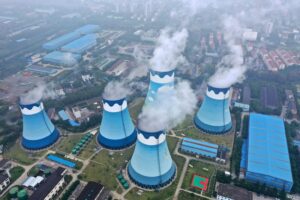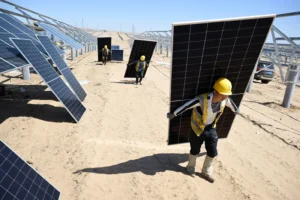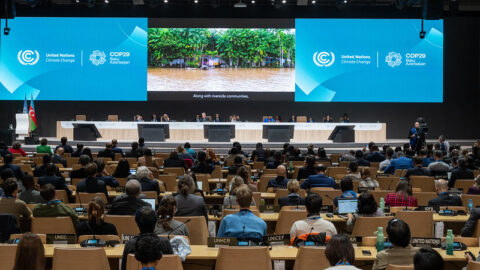China’s power sector is both the world’s largest emitter and the largest source of clean-energy growth, making it essential to global climate efforts.
This means it will be a key part of China’s next nationally determined contribution (NDC) – its climate pledge under the Paris Agreement for 2035 – which all countries are expected to publish by this year.
Yet, at the same time, Chinese policymakers are grappling with perceived tensions between ensuring a reliable energy supply amid uncertain demand growth and future cost trajectories, which have the potential to weigh down climate ambition.
In our new study, co-authored with experts from Tsinghua University and published in Cell Reports Sustainability, we model pathways for China’s power system up to 2035 that are consistent with its wider climate goals, incorporating a wide range of scenarios and uncertainties currently being debated in the country.
We find that China would need to deploy 2,350-2,780 gigawatts (GW) of wind and solar by 2030 and 2,910-3,800GW by 2035 – roughly double current levels – to be consistent with a target of limiting the rise in global temperatures to 2C this century.
Furthermore, ensuring that the share of wind and solar generation reaches around 40% by 2030 and 50% by 2035 would set the power sector up for the longer-term transition to carbon neutrality by 2060.
Electricity generation from non-fossil fuels more broadly would reach around 50% by 2030 and more than 70% by 2035.
China’s climate ambitions
China’s “dual-carbon” goals, announced in 2020, aim to peak carbon emissions by 2030 and reach carbon neutrality by 2060. The country has already surpassed its 2030 renewable deployment target – 1,200GW of wind and solar – six years ahead of schedule, due to record-breaking annual additions of around 300GW of new capacity for two years in a row.
However, new coal-power developments and rapid growth in electricity demand pose a threat to meeting China’s other targets, such as emissions intensity and share of non-fossil fuel in the energy mix.
China began building nearly 95GW of new coal capacity in 2024, representing 93% of the world’s new coal capacity under construction.
If completed, China’s coal fleet – already the largest in the world – would expand to an installed capacity of 1,190GW.
This resurgence stems in large part from concerns surrounding energy security. China faced unprecedented power shortages in 2021 and 2022, while annual electricity demand has recently reached 10 petawatt-hours (PWh, or 10,000 terawatt hours) – a level that most studies predicted would not be reached until 2030.
This keeps the door open to continued growth in China’s electricity generation and emissions from coal, unless the expansion of clean energy is able to keep pace.
Setting the renewable energy pace
Our research looks at the rate of growth from clean energy that would be required to not only meet China’s rapidly rising demand for electricity, but also to push down its coal generation and squeeze emissions from the power sector.
We simulate a range of system “baselines” for 2030 and “scenarios” for 2035, under varying assumptions about electricity demand growth, carbon emissions limits, renewable energy costs and meteorological conditions.
The model includes detailed representations of where renewable energy capacity could be built and how the power sector could be operated efficiently.
It evaluates wind and solar resources and deployment potential at a level that is detailed enough to help capture regional differences and localised impacts, such as land use, socio-economic benefits and infrastructure needs.
The results are organised into 15 scenarios, categorised into three main groups: moderate growth in electricity demand (group A); rapid electrification (group B); and ambitious decarbonisation (group C).
The modelling is based around two different scenarios for China that are compatible with a global limit of 2C warming this century.
The basic 2C trajectory would see China’s power-sector emissions fall to 36% below 2024 levels by 2035, whereas the more ambitious 2C trajectory has a 42% decline.
The chart below shows recent electricity demand (left) and the carbon dioxide (CO2) emissions of China’s power sector (right), as well as how these might evolve under the different scenarios modelled for the paper.
The modelling accounts for recent trends suggesting that China’s electricity demand could reach 13.5PWh by 2035 (groups A and C). However, accommodating faster demand growth under a rapid electrification scenario (group B) would require China to deploy low-carbon energy even more rapidly, if it is to maintain pace with climate targets.
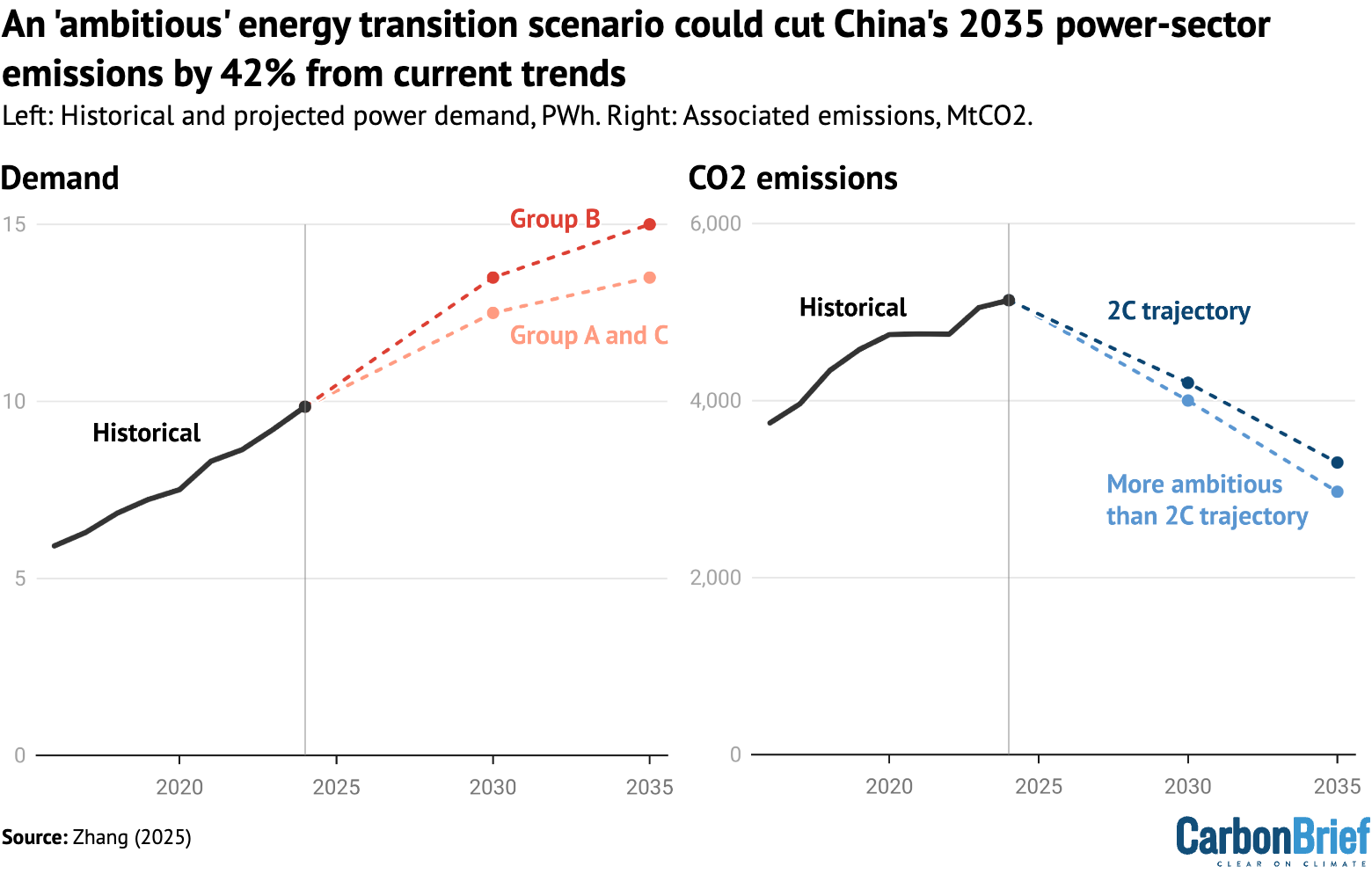
The modelling shows that wind and solar energy would need to supply around 40% of China’s electricity by 2030, if the country aims to remain on track for 2C of global warming. Solar and wind power generation would need to then rise to 50% by 2035 – up from 17.9% in 2024.
This growth would substantially reduce the system’s reliance on coal and other fossil fuels, which would decrease to 35% of generation in 2030 and 25% in 2035.
The more ambitious scenario, which targets limiting global warming since the pre-industrial period to between 1.5C and 2C, would lead to even higher wind and solar generation shares of 44% by 2030 and 54% by 2035.
Under the different scenarios, China’s wind and solar capacity would rise from around 1,700GW today to 2,350-2,780GW by 2030 and 2,910-3,800GW by 2035. Meeting this level of renewable deployment would require annual additions of 120-220GW.
Recent wind and solar additions have already exceeded this pace, but challenges with grid integration and supporting infrastructure could, nevertheless, slow future large-scale buildouts.
According to industry reports, 6.8% of wind and 6.1% of solar power generation were “curtailed” in the first four months of 2025, meaning the output could not be accommodated by the electricity grid and was wasted.
At the provincial level, wind and solar curtailment rates exceeded 10% in renewable-rich regions, such as Xinjiang, Gansu and Qinghai. To achieve the cost-efficient pathways modeled here, curtailment rates fall to 3-6%.
To achieve this level of integration, energy storage and transmission infrastructure will be necessary to shift renewable generation towards when and where it is needed.
Battery and grid capacity would need to rise by 6% and 5% per year from current levels out to 2035, respectively, in order to better integrate renewables into the grid.
Boosting wind and solar generation share
In order to explore the implications of uncertainty on China’s power system in 2030, the modelling includes three core scenarios (groups A-C).
Within these core groups, the modelling looks at the impact of further uncertainties on system outcomes by 2035, labelled A1, A2 and so on. This results in a “decision-tree” structure that outlines a range of possible futures.
The lines on the chart below show the share of China’s electricity that would be generated by wind and solar by 2030 and 2035, under each of these different futures. The coloured columns show the share of electricity generated by wind (red), solar (yellow), hydro (blue), nuclear (pink) and biomass (grey) in one specific scenario, namely, the “reference” case for renewable costs with moderate demand growth (A1).
The bands in the right-hand margin indicate the ranges of the 2035 results under all of the future scenarios, depending on variables such as the cost of renewables or batteries (cases two to four) and a larger rise in demand (case five).
At a minimum, for each of the 2C-compatible scenarios, wind and solar would take up around 50% of total generation by 2035.
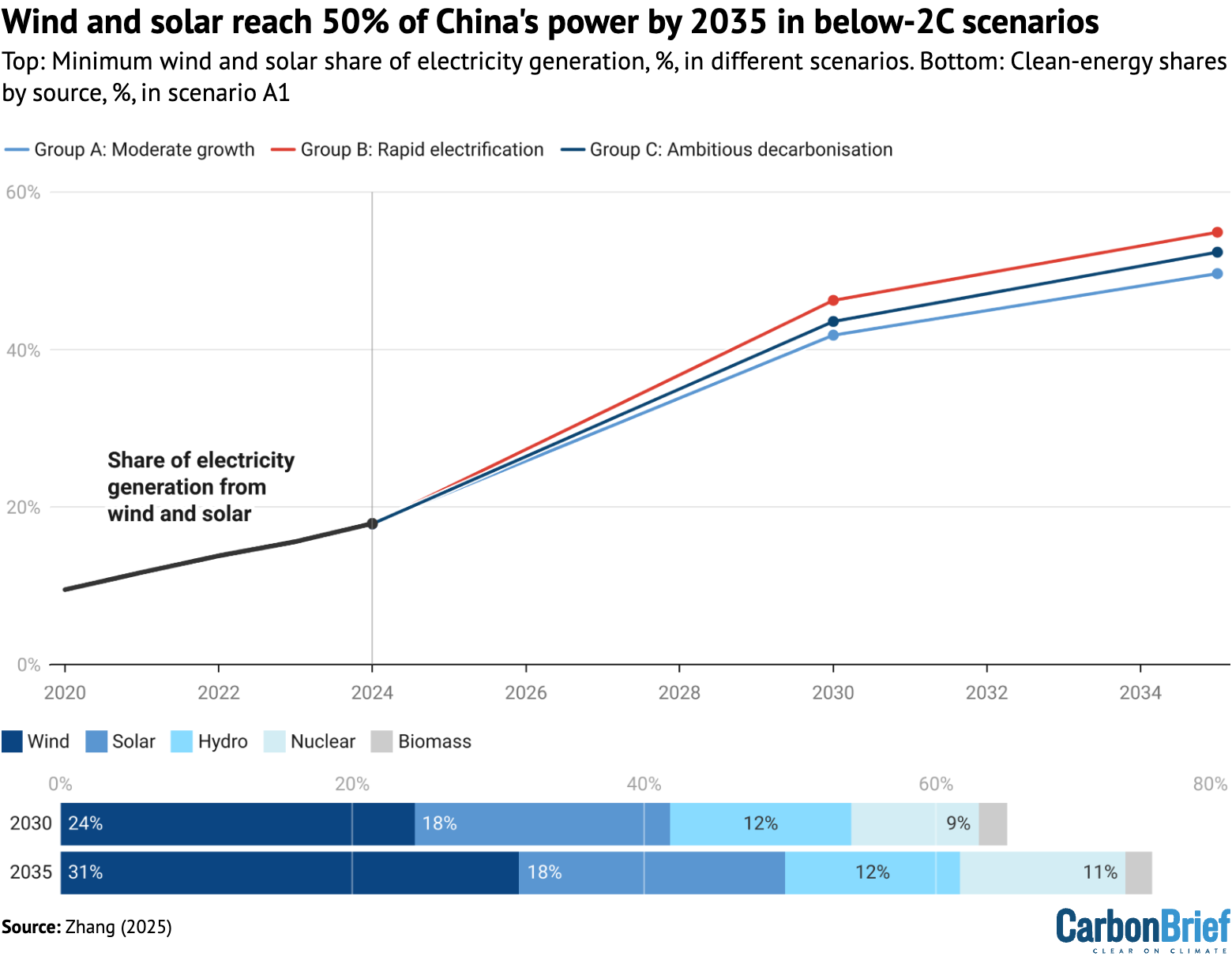
Another consistent result across all scenarios is the need for more transmission capacity to shift generation from renewable-rich regions to those with high demand for power. By 2030, at least 225GW of new inter-provincial transmission capacity would be required, further enhancing electricity trading and grid reliability.
China is already expanding its “ultra-high-voltage” (UHV) transmission network at breakneck speed. As of the end of 2024, there were 42 UHV projects in operation, with a combined capacity exceeding 300GW.
Another assumption in the modelling is that electricity can flow freely and efficiently across regions, up to the transmission capacity limits. But, in reality, institutional and regulatory barriers complicate regional electricity trading.
China plans to establish a national unified power market by 2029. As such, deregulating the power sector is seen as an essential measure to enhance the power system’s operational efficiency and facilitate renewable energy integration.
Looking ahead to the NDC and beyond
Many experts have weighed in on China’s NDC target-setting, largely focusing on economy-wide emissions targets and non-CO2 greenhouse gases.
While these are indeed important elements of China’s next international climate pledge, our study seeks to identify robust power-sector targets that could support the country’s overall ambition and provide credible signals to energy planners.
Due to the rapidly evolving economic and geopolitical situation, there are good reasons to expect that China’s topline emissions number may be underwhelming.
On the other hand, there is an opportunity to emphasise and expand ambition within the power sector through additional sectoral targets. This would put a focus on quantifiable metrics that can guide investments and planning by state-owned enterprises and local governments.
While China has previously set a target for the absolute capacity of wind and solar, a goal for the share of electricity generation from these technologies, or for clean energy more broadly, would set a narrower range for future emissions from the power sector.
Given current uncertainties around the pace of power demand growth, for example, a target for clean energy share might provide greater confidence to policymakers than a capacity target alone.
Regardless of what targets are set, achieving the growth of clean energy modelled in our study would support China’s long-term climate commitments and demonstrate the nation’s intent to be a clean-energy powerhouse.
The post Guest post: What an ‘ambitious’ 2035 electricity target looks like for China appeared first on Carbon Brief.
Guest post: What an ‘ambitious’ 2035 electricity target looks like for China
Climate Change
Efforts to green lithium extraction face scrutiny over water use
Mining companies are showcasing new technologies which they say could extract more lithium – a key ingredient for electric vehicle (EV) batteries – from South America’s vast, dry salt flats with lower environmental impacts.
But environmentalists question whether the expensive technology is ready to be rolled out at scale, while scientists warn it could worsen the depletion of scarce freshwater resources in the region and say more research is needed.
The “lithium triangle” – an area spanning Argentina, Bolivia and Chile – holds more than half of the world’s known lithium reserves. Here, lithium is found in salty brine beneath the region’s salt flats, which are among some of the driest places on Earth.
Lithium mining in the region has soared, driven by booming demand to manufacture batteries for EVs and large-scale energy storage.
Mining companies drill into the flats and pump the mineral-rich brine to the surface, where it is left under the sun in giant evaporation pools for 18 months until the lithium is concentrated enough to be extracted.
The technique is relatively cheap but requires vast amounts of land and water. More than 90% of the brine’s original water content is lost to evaporation and freshwater is needed at different stages of the process.
One study suggested that the Atacama Salt Flat in Chile is sinking by up to 2 centimetres a year because lithium-rich brine is being pumped at a faster rate than aquifers are being recharged.
Lithium extraction in the region has led to repeated conflicts with local communities, who fear the impact of the industry on local water supplies and the region’s fragile ecosystem.
The lithium industry’s answer is direct lithium extraction (DLE), a group of technologies that selectively extracts the silvery metal from brine without the need for vast open-air evaporation ponds. DLE, it argues, can reduce both land and water use.
Direct lithium extraction investment is growing
The technology is gaining considerable attention from mining companies, investors and governments as a way to reduce the industry’s environmental impacts while recovering more lithium from brine.
DLE investment is expected to grow at twice the pace of the lithium market at large, according to research firm IDTechX.
There are around a dozen DLE projects at different stages of development across South America. The Chilean government has made it a central pillar of its latest National Lithium Strategy, mandating its use in new mining projects.
Last year, French company Eramet opened Centenario Ratones in northern Argentina, the first plant in the world to attempt to extract lithium solely using DLE.
Eramet’s lithium extraction plant is widely seen as a major test of the technology. “Everyone is on the edge of their seats to see how this progresses,” said Federico Gay, a lithium analyst at Benchmark Mineral Intelligence. “If they prove to be successful, I’m sure more capital will venture into the DLE space,” he said.
More than 70 different technologies are classified as DLE. Brine is still extracted from the salt flats but is separated from the lithium using chemical compounds or sieve-like membranes before being reinjected underground.
DLE techniques have been used commercially since 1996, but only as part of a hybrid model still involving evaporation pools. Of the four plants in production making partial use of DLE, one is in Argentina and three are in China.
Reduced environmental footprint
New-generation DLE technologies have been hailed as “potentially game-changing” for addressing some of the issues of traditional brine extraction.
“DLE could potentially have a transformative impact on lithium production,” the International Lithium Association found in a recent report on the technology.
Firstly, there is no need for evaporation pools – some of which cover an area equivalent to the size of 3,000 football pitches.
“The land impact is minimal, compared to evaporation where it’s huge,” said Gay.
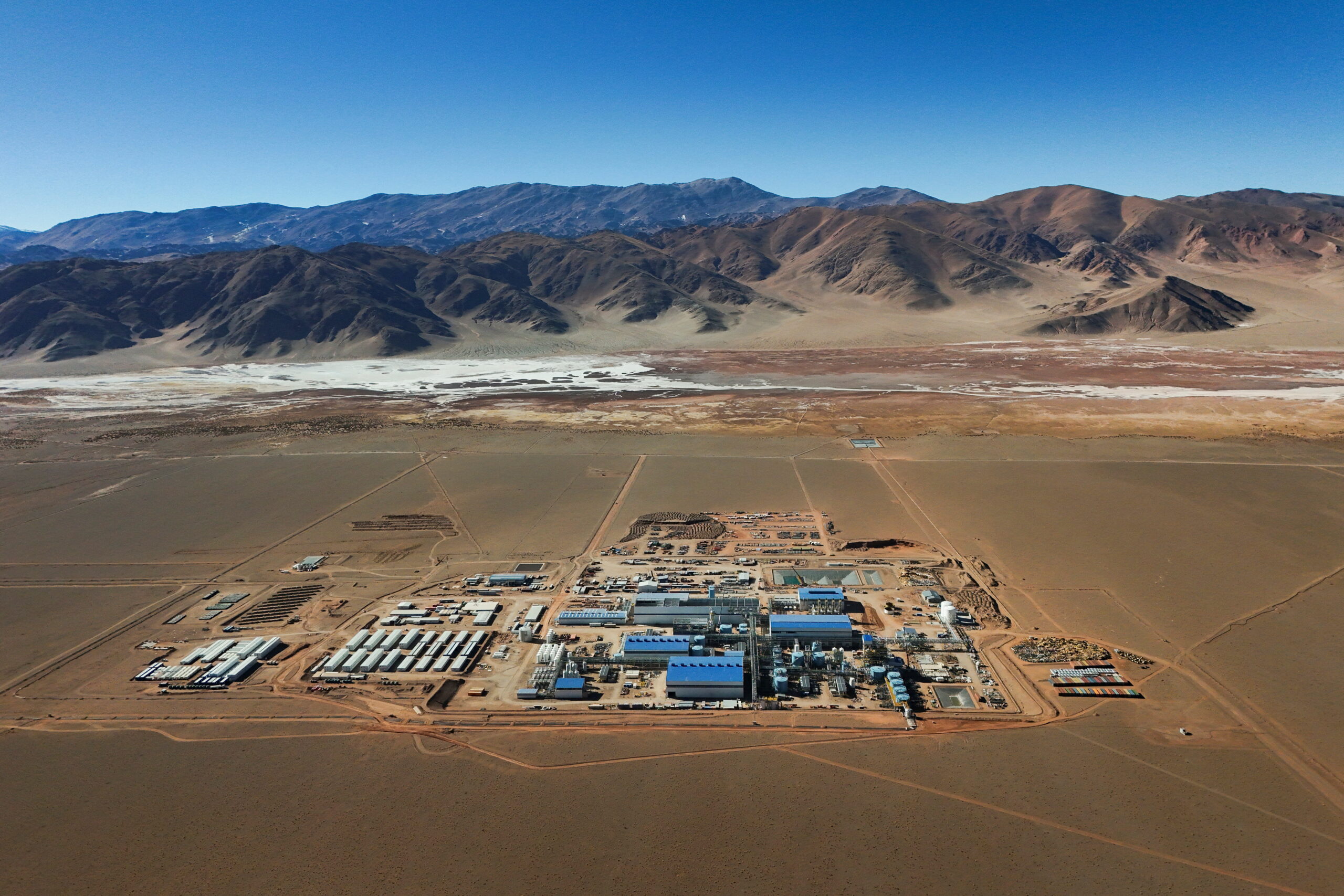

The process is also significantly quicker and increases lithium recovery. Roughly half of the lithium is lost during evaporation, whereas DLE can recover more than 90% of the metal in the brine.
In addition, the brine can be reinjected into the salt flats, although this is a complicated process that needs to be carefully handled to avoid damaging their hydrological balance.
However, Gay said the commissioning of a DLE plant is currently several times more expensive than a traditional lithium brine extraction plant.
“In theory it works, but in practice we only have a few examples,” Gay said. “Most of these companies are promising to break the cost curve and ramp up indefinitely. I think in the next two years it’s time to actually fulfill some of those promises.”
Freshwater concerns
However, concerns over the use of freshwater persist.
Although DLE doesn’t require the evaporation of brine water, it often needs more freshwater to clean or cool equipment.
A 2023 study published in the journal Nature reviewed 57 articles on DLE that analysed freshwater consumption. A quarter of the articles reported significantly higher use of freshwater than conventional lithium brine mining – more than 10 times higher in some cases.
“These volumes of freshwater are not available in the vicinity of [salt flats] and would even pose problems around less-arid geothermal resources,” the study found.
The company tracking energy transition minerals back to the mines
Dan Corkran, a hydrologist at the University of Massachusetts, recently published research showing that the pumping of freshwater from the salt flats had a much higher impact on local wetland ecosystems than the pumping of salty brine. “The two cannot be considered equivalent in a water footprint calculation,” he said, explaining that doing so would “obscure the true impact” of lithium extraction.
Newer DLE processes are “claiming to require little-to-no freshwater”, he added, but the impact of these technologies is yet to be thoroughly analysed.
Dried-up rivers
Last week, Indigenous communities from across South America held a summit to discuss their concerns over ongoing lithium extraction.
The meeting, organised by the Andean Wetlands Alliance, coincided with the 14th International Lithium Seminar, which brought together industry players and politicians from Argentina and beyond.
Indigenous representatives visited the nearby Hombre Muerto Salt Flat, which has borne the brunt of nearly three decades of lithium extraction. Today, a lithium plant there uses a hybrid approach including DLE and evaporation pools.
Local people say the river “dried up” in the years after the mine opened. Corkran’s study linked a 90% reduction in wetland vegetation to the lithium’s plant freshwater extraction.
Pia Marchegiani, of Argentine environmental NGO FARN, said that while DLE is being promoted by companies as a “better” technique for extraction, freshwater use remained unclear. “There are many open questions,” she said.
AI and satellite data help researchers map world’s transition minerals rush
Stronger regulations
Analysts speaking to Climate Home News have also questioned the commercial readiness of the technology.
Eramet was forced to downgrade its production projections at its DLE plant earlier this year, blaming the late commissioning of a crucial component.
Climate Home News asked Eramet for the water footprint of its DLE plant and whether its calculations excluded brine, but it did not respond.
For Eduardo Gigante, an Argentina-based lithium consultant, DLE is a “very promising technology”. But beyond the hype, it is not yet ready for large-scale deployment, he said.
Strong regulations are needed to ensure that the environmental impact of the lithium rush is taken seriously, Gigante added.
In Argentina alone, there are currently 38 proposals for new lithium mines. At least two-thirds are expected to use DLE. “If you extract a lot of water without control, this is a problem,” said Gigante. “You need strong regulations, a strong government in order to control this.”
The post Efforts to green lithium extraction face scrutiny over water use appeared first on Climate Home News.
Efforts to green lithium extraction face scrutiny over water use
Climate Change
Maryland’s Conowingo Dam Settlement Reasserts State’s Clean Water Act Authority but Revives Dredging Debate
The new agreement commits $340 million in environmental investments tied to the Conowingo Dam’s long-term operation, setting an example of successful citizen advocacy.
Maryland this month finalized a $340 million deal with Constellation Energy to relicense the Conowingo Dam in Cecil County, ending years of litigation and regulatory uncertainty. The agreement restores the state’s authority to enforce water quality standards under the Clean Water Act and sets a possible precedent for dozens of hydroelectric relicensing cases nationwide expected in coming years.
Climate Change
A Michigan Town Hopes to Stop a Data Center With a 2026 Ballot Initiative
Local officials see millions of dollars in tax revenue, but more than 950 residents who signed ballot petitions fear endless noise, pollution and higher electric rates.
This is the second of three articles about Michigan communities organizing to stop the construction of energy-intensive computing facilities.
A Michigan Town Hopes to Stop a Data Center With a 2026 Ballot Initiative
-
Climate Change2 years ago
Spanish-language misinformation on renewable energy spreads online, report shows
-
Climate Change2 months ago
Guest post: Why China is still building new coal – and when it might stop
-
Climate Change Videos2 years ago
The toxic gas flares fuelling Nigeria’s climate change – BBC News
-

 Greenhouse Gases1 year ago
Greenhouse Gases1 year ago嘉宾来稿:满足中国增长的用电需求 光伏加储能“比新建煤电更实惠”
-
Greenhouse Gases2 months ago
Guest post: Why China is still building new coal – and when it might stop
-

 Climate Change1 year ago
Climate Change1 year ago嘉宾来稿:满足中国增长的用电需求 光伏加储能“比新建煤电更实惠”
-

 Carbon Footprint2 years ago
Carbon Footprint2 years agoUS SEC’s Climate Disclosure Rules Spur Renewed Interest in Carbon Credits
-
Renewable Energy3 months ago
US Grid Strain, Possible Allete Sale


